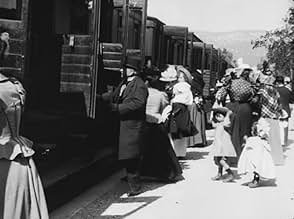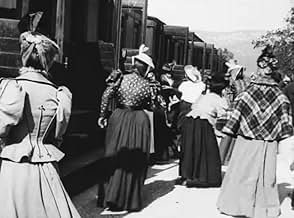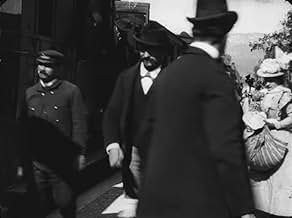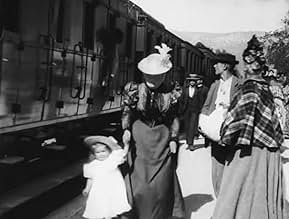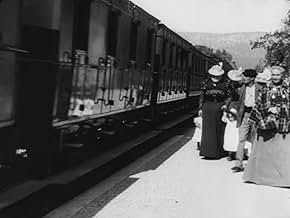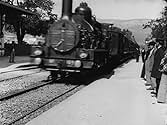NOTE IMDb
7,4/10
14 k
MA NOTE
Ajouter une intrigue dans votre langueA train arrives at La Ciotat station.A train arrives at La Ciotat station.A train arrives at La Ciotat station.
- Réalisation
- Casting principal
Avis à la une
10jhaugh
Having invented a hand-cranked, motion-picture camera during the year 1894 - and making films that could be exhibited to scientific groups during the early months of 1895; Louis Lumiere was a driven man. During one exhibition of the Cinematograph at the Societe d'Encouragement pour l'Industrie Nationale, he met an engineer (Jules Carpentier) who wished to manufacture the invention for selling in Paris. Louis accepted the proposal. Initial production would be 25 units. They would be professionally manufactured as opposed to the inventors experimental camera. Louis continued to use this camera to gather enough views for a public presentation at the end of the year.
There were a number of problems in producing the first prototype of the twenty-five units. Even when Louis, exhausted, took some rest-and-relaxation at the Lumiere's vacation house in the town of le Ciotat (pronounced see-oh-tah), he could not relax; and remained in constant communication with Jules in Paris. Louis was able to communicate on a daily basis with Jules because the mail trains of "le P.L.M. (Paris-Lyon-Mediterranee)" railway provided him with a means of staying in touch as well as providing his transportation between Lyon and la Ciotat.
Still driven by his work, he decided to go to the station and use the arriving train as one of his subjects. Perhaps wanting to assure that there would be plenty of action to record on the station platform, he took along his mother, his wife, and his two children along with their nanny. They all ventured forth, on a bright sunshiny Mediteranean day - la Ciotat is on the southern coast of France, between Marseille and Toulon, where people came to sunbathe and fish - the group ventured forth to the train station on the northern edge of the town with the verdant foothills of the Alpes de Provence providing a backdrop to the railroad.
Louis' wife, in a neck-to-foot elegant dress with a pristine white bonnet, and the nanny were instructed to run around the platform and appear as if they were trying to locate an expected-arriver as the train ground to a halt. The mother, in a shawl, would quietly observe - as a good matriarch should. Louis could not position his camera and let the train chug from right to left across the view because he would just capture a blur. He positioned it very near the track so the train would be seen in its entire length; and then rattle by very close to the viewer. The station personnel, in uniform, would hold back the crowd of departing people on the platform until the train had halted.
So the train arrives; locomotive and tender pass to the left of the camera followed by a mail car and a string of passenger cars. Louis has been cranking since the train was in good view. The crowd on platform can be restrained no more. They break ranks and move to the platform edge, ready to board, as the train stops. The two women with children in hand bustle about looking for someone. The matriarch stands still - observing. A young, and unscripted, peasant lad wanders about seemingly unsure as to where he should go to find his car. Dazed by the adventure of his first train ride? Then the doors open (on the French railway equipment the compartments are entered/exited directly to the platform.) Passengers begin to detrain. Louis has run out of film and stops cranking.
The first railroad train to star in a movie prepares to move on to Toulon (on schedule no doubt.)
There were a number of problems in producing the first prototype of the twenty-five units. Even when Louis, exhausted, took some rest-and-relaxation at the Lumiere's vacation house in the town of le Ciotat (pronounced see-oh-tah), he could not relax; and remained in constant communication with Jules in Paris. Louis was able to communicate on a daily basis with Jules because the mail trains of "le P.L.M. (Paris-Lyon-Mediterranee)" railway provided him with a means of staying in touch as well as providing his transportation between Lyon and la Ciotat.
Still driven by his work, he decided to go to the station and use the arriving train as one of his subjects. Perhaps wanting to assure that there would be plenty of action to record on the station platform, he took along his mother, his wife, and his two children along with their nanny. They all ventured forth, on a bright sunshiny Mediteranean day - la Ciotat is on the southern coast of France, between Marseille and Toulon, where people came to sunbathe and fish - the group ventured forth to the train station on the northern edge of the town with the verdant foothills of the Alpes de Provence providing a backdrop to the railroad.
Louis' wife, in a neck-to-foot elegant dress with a pristine white bonnet, and the nanny were instructed to run around the platform and appear as if they were trying to locate an expected-arriver as the train ground to a halt. The mother, in a shawl, would quietly observe - as a good matriarch should. Louis could not position his camera and let the train chug from right to left across the view because he would just capture a blur. He positioned it very near the track so the train would be seen in its entire length; and then rattle by very close to the viewer. The station personnel, in uniform, would hold back the crowd of departing people on the platform until the train had halted.
So the train arrives; locomotive and tender pass to the left of the camera followed by a mail car and a string of passenger cars. Louis has been cranking since the train was in good view. The crowd on platform can be restrained no more. They break ranks and move to the platform edge, ready to board, as the train stops. The two women with children in hand bustle about looking for someone. The matriarch stands still - observing. A young, and unscripted, peasant lad wanders about seemingly unsure as to where he should go to find his car. Dazed by the adventure of his first train ride? Then the doors open (on the French railway equipment the compartments are entered/exited directly to the platform.) Passengers begin to detrain. Louis has run out of film and stops cranking.
The first railroad train to star in a movie prepares to move on to Toulon (on schedule no doubt.)
I have little to add to other reviewers, except to say that this film took a sudden importance in my life last year. In 2002 I was travelling by train to my first ever Cannes Film Festival. At one point the train was moving slowly and I looked out of the window and found that we were pulling through La Ciotat, and the platform hadn't changed a bit. Sadly the train didn't stop, otherwise I would have been tempted to jump off for a moment, but given the purpose of my journey I felt a strange thrill at being there. Just a little personal anecdote, but perhaps it shows something of the power and importance of those early steps in film.
At just under a minute, L'Arrivée d'un train à La Ciotat (1895) is one of Louis Lumiere's earliest excursions into film-making. As was formulaic with what he called "actualités," or non-narrative shorts, Louis Lumiere set up his cinematographe (a portable crank-handled camera that triples as a film projector and developer) at such an accomplished angle as to catch the arrival of a train at La Ciotat, where it captures the bustling comers-and-goers of the station who happen to stray in front of the lens, looking altogether curious, or else wary of the unfamiliar contraption. The crowd seems lively enough, but just for good measure, Lumiere's refined wife and mother-in-law can be seen actively searching for an imaginary, but eagerly expected passenger.
As uninteresting as it is (and it IS, even for the most pretentious film buff), L'Arrivée d'un train à La Ciotat's historical appeal is undeniable, if not legendary. The film's effect upon its first public viewing is a well-worn myth told to enthusiastic film students by their professors. Apparently, initial audiences, unaware of film's capacity to fully imitate reality, fled in fear of the image of a train barreling down upon the screen. The French newspaper, Le courrier du centre, (July 14, 1896) alleged the advancing locomotive made "spectators draw back instinctively fearing they'd be run over by the steel monster." Nevertheless, such a widespread and instantaneous physical response seems foolish or naïve even then, especially when the projector would have been visible and the sound audible to all seated in what at that time passed as a "theater." In reality, it is far more likely that this incident was limited to a few isolated cases, and was later exaggerated to enhance its appeal and boost the film's reputation. Consequently, the commerciality of the venture succeeded with tremendous results. Over a hundred years later, not only is L'Arrivée d'un train à La Ciotat a cinematic icon, but proof of how powerful and impressionable moving pictures could (and would) become.
Recommended for those with an interest in film as an art form, or for those looking for early examples of film in history.
As uninteresting as it is (and it IS, even for the most pretentious film buff), L'Arrivée d'un train à La Ciotat's historical appeal is undeniable, if not legendary. The film's effect upon its first public viewing is a well-worn myth told to enthusiastic film students by their professors. Apparently, initial audiences, unaware of film's capacity to fully imitate reality, fled in fear of the image of a train barreling down upon the screen. The French newspaper, Le courrier du centre, (July 14, 1896) alleged the advancing locomotive made "spectators draw back instinctively fearing they'd be run over by the steel monster." Nevertheless, such a widespread and instantaneous physical response seems foolish or naïve even then, especially when the projector would have been visible and the sound audible to all seated in what at that time passed as a "theater." In reality, it is far more likely that this incident was limited to a few isolated cases, and was later exaggerated to enhance its appeal and boost the film's reputation. Consequently, the commerciality of the venture succeeded with tremendous results. Over a hundred years later, not only is L'Arrivée d'un train à La Ciotat a cinematic icon, but proof of how powerful and impressionable moving pictures could (and would) become.
Recommended for those with an interest in film as an art form, or for those looking for early examples of film in history.
Like the notorious inflation adjustment that gives Gone With the Wind (1939) the unbreakable box-office high, a slight technological adjustment given the time (109 years ago!) gives Arrival of a Train at La Ciotat (1895) the best special effects ever (relatively speaking, of course). Forget King Kong (1933), throw out Star Wars (1977), Arrival of a Train' blew audiences away with a little thing called moving pictures. There's a classic rumor of audiences running away from the movie screen, expecting the train to crash right through! As scary as Kong was, nobody expected him to reach into the audience and pick out a few snacks!
Also, it may not have been all that intentional, but the composition of this static, one-minute shot is excellent, and still unrivaled. The perspective of the train zooming past the lens like a wild stampede, the quick stop, then, the explosion of activity: people coming, going, on the train, off the train. What crisp energy! What a film! Viva la Lumiere!
Also, it may not have been all that intentional, but the composition of this static, one-minute shot is excellent, and still unrivaled. The perspective of the train zooming past the lens like a wild stampede, the quick stop, then, the explosion of activity: people coming, going, on the train, off the train. What crisp energy! What a film! Viva la Lumiere!
On December 28, 1895, at Paris's Salon Indien Du Grand Café, the brothers Auguste and Louis Lumière transformed the industry of entertainment when they did a demonstration of their new invention. The brothers projected a series of images on a screen, but those images were nothing like a normal slide-show, those images were moving as if they were alive. While the idea of motion pictures wasn't new to the audience (Edison's Kinetoscope was a popular entertainment), the devise's ability to project them on a screen was something they had never seen before. 10 short films of barely a minute of duration each were shown that day, and the invention proved to be an enormous success for the brothers, so immediately they decide to keep making movies in order to improve their catalog. One of those new movies would become the first iconic image of the new art.
"L' Arrivée d'un train à La Ciotat" (literally, "Arrival of a Train at La Ciotat") is without a doubt, one of the most famous films in history, as its image of a train arriving to the station, passing very close to the camera as it slows its speed, quickly became an iconic scene of the new invention. While initially conceived as just another one of the brothers' many "actuality films", it's clear that director Louis Lumière knew exactly where to put his camera in order to get the best image of the event as the film shows he had a good idea of the use of perspective (many consider it a study about long shot, medium shot and close-up). As a side-note, this is the film that originated the classic urban legend about people running away scared from the arriving train, thinking it was a real locomotive what was appearing on the screen.
While this famous tale has been debunked by historians as a fake story, it's existence is another testament of this movie's importance and continuous influence on the younger generations. Among the many different art-forms that we can find today, cinema is perhaps the one that better reflects the modern society that arose after the industrial revolution of the 19th Century; because, as painting and sculpture did before, it has become a keeper of the most representative icons of our history. "L' Arrivée d'un train à La Ciotat" was not the first movie the brothers screened, and it definitely wasn't the first movie ever made, but despite those details, the image of the arriving train represents the first icon of cinema, and literally, the arrival of a new art form. 9/10
"L' Arrivée d'un train à La Ciotat" (literally, "Arrival of a Train at La Ciotat") is without a doubt, one of the most famous films in history, as its image of a train arriving to the station, passing very close to the camera as it slows its speed, quickly became an iconic scene of the new invention. While initially conceived as just another one of the brothers' many "actuality films", it's clear that director Louis Lumière knew exactly where to put his camera in order to get the best image of the event as the film shows he had a good idea of the use of perspective (many consider it a study about long shot, medium shot and close-up). As a side-note, this is the film that originated the classic urban legend about people running away scared from the arriving train, thinking it was a real locomotive what was appearing on the screen.
While this famous tale has been debunked by historians as a fake story, it's existence is another testament of this movie's importance and continuous influence on the younger generations. Among the many different art-forms that we can find today, cinema is perhaps the one that better reflects the modern society that arose after the industrial revolution of the 19th Century; because, as painting and sculpture did before, it has become a keeper of the most representative icons of our history. "L' Arrivée d'un train à La Ciotat" was not the first movie the brothers screened, and it definitely wasn't the first movie ever made, but despite those details, the image of the arriving train represents the first icon of cinema, and literally, the arrival of a new art form. 9/10
Le saviez-vous
- AnecdotesPopular legend has it that, when this film was shown, the audience fled in terror, fearing being run over by the "approaching" train. This legend has since been identified as promotional embellishment, though there is evidence to suggest that people were astounded at the capabilities of the Lumières' cinématographe.
- ConnexionsEdited into Louis Lumière (1968)
Meilleurs choix
Connectez-vous pour évaluer et suivre la liste de favoris afin de recevoir des recommandations personnalisées
Détails
- Date de sortie
- Pays d’origine
- Langue
- Aussi connu sous le nom de
- L'arrivée d'un train en gare de La Ciotat
- Lieux de tournage
- Société de production
- Voir plus de crédits d'entreprise sur IMDbPro
- Durée1 minute
- Couleur
- Mixage
- Rapport de forme
- 1.31 : 1
Contribuer à cette page
Suggérer une modification ou ajouter du contenu manquant

Lacune principale
By what name was L'arrivée d'un train à La Ciotat (1896) officially released in India in English?
Répondre
